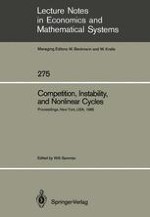1986 | OriginalPaper | Buchkapitel
Swinging along the Autostrada
verfasst von : Richard M. Goodwin
Erschienen in: Competition, Instability, and Nonlinear Cycles
Verlag: Springer Berlin Heidelberg
Enthalten in: Professional Book Archive
Aktivieren Sie unsere intelligente Suche, um passende Fachinhalte oder Patente zu finden.
Wählen Sie Textabschnitte aus um mit Künstlicher Intelligenz passenden Patente zu finden. powered by
Markieren Sie Textabschnitte, um KI-gestützt weitere passende Inhalte zu finden. powered by
The greatest mistake in my career occurred when Schumpeter came to me in 1938 or ’39 and asked me to report on a very important new publication: the von Neumann paper given at the Monger seminar, a repetition of the one he had given in Princeton in 1932. When I got as far as realizing that he was including all remaining plant and equipment in annual output, I rashly judged it to be totally unrealistic, and I still do, though in retrospect I realize the immense simplifying power of the method. In any case, I, alas, reported back to Schumpeter that it was no more than a piece of mathematical ingenuity, failing to see that it contained two aspects close to Schumpeter’s heart — a rigorous solution to Walras’s central problem and a demonstration that the rate of profit arose from growth not quantity of capital. When I came to edit his papers for the final section of his History, I found no reference to what now appears to me to be one of the great, seminal works of this century, the omission being possibly the result of my own blindness. The beautifully spare architecture of its encompassing structure leaves one awestruck. Apparently without antecedents, it sprang full blown from that fertile brain. Demonstrating the existence of a solution to the economic problem wherein all goods could be produced at the lowest price and the greatest possible quantity, with price equal to cost and supply equal to demand for all goods, along with showing the necessity for maximal growth if dynamic equilibrium is to exist. So grandiose an achievement was, of course, achieved at a cost. My purpose here is to suggest how one may, with a modest reformulation, bring it closer to reality, without damaging its essentially robust and clarifying solutions. The von Neumann theory may appropriately be considered the progenitor of contemporary growth theory since it demonstrated that a decentralized, capitalist economy had to grow at a determinate, constant rate to clear its markets. Profoundly true though in some sense it is, this type of theory is painfully unrealistic for the turbulent history of industrial capitalism. Not only that but it contains two quite unacceptable assumptions: there is no technical progress and there is a constant real wage. The maximal growth rate depends vitally on the real wage, but the wage is exogenous instead of being determined by the functioning of the system. My proposal is that the economy first overshoots and then undershoots the von Neumann solution, but that, on the average over a longer period, achieves an analogous solution to his, thus leaving the essential result undamaged.
